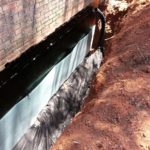Basement Waterproofing

SERVICE OVERVIEW
Basement Waterproofing refers to techniques used to prevent water from entering the basement of a house or building.
Effective below ground waterproofing will include both drainage and sealers. Waterproofing is needed anytime a structure is built at ground level or below ground. Waterproofing and drainage considerations are especially needed in cases where ground water is likely to build up in the soil and raise the water table. This higher water table causes hydrostatic pressure to be exerted underneath basement floors and against basement walls. Hydrostatic pressure forces water in through cracks in foundation walls, through openings caused by expansion and contraction of the footing-foundation wall joint and up through floor cracks. Hydrostatic pressure can cause major structural damage to foundation walls and is likely to contribute to mold, decay and other moisture related problems.
Exterior waterproofing prevents water from entering foundation walls therefore preventing the wicking and molding of building materials. Waterproofing a structure from the exterior is the only method the IBC (International Building Code) recognizes as adequate to prevent structural damage caused by water intrusion. Prior to the 1980s much of the original exterior waterproofing was actually damp-proofing using a degradable asphalt-based covering. Today, many older homes and buildings suffer from waterproofing problems as a result of the use of this degradable product. Waterproofing an existing basement begins with excavating to the bottom sides of the footers. Once excavated, the walls are then sealed with a waterproofing membrane and new drainage (weeping tiles) are placed at the side of the footing.
